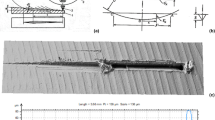Abstract
The study of bonding hard materials such as aluminium oxide and cubic boron nitride (cBN) and the nature of interfacial cohesion between these materials and glass is very important from the perspective of high precision grinding. Vitrified grinding wheels are typically used to remove large volumes of metal and to produce components with very high tolerances. It is expected that the same grinding wheel is used for both rough and finish machining operations. Therefore, the grinding wheel, and in particular its bonding system, is expected to react differently to a variety of machining operations. In order to maintain the integrity of the grinding wheel, the bonding system that is used to hold abrasive grains in place reacts differently to forces that are placed on individual bonding bridges. This paper examines the role of vitrification heat treatment on the development of strength between abrasive grains and bonding bridges, and the nature of fracture and wear in vitrified grinding wheels that are used for precision grinding applications.
Similar content being viewed by others
References
Bhattacharyya S K, Grisbrook H, Moran H 1965 Analysis of grit fracture with changes in grinding conditions.Microtechnic. 22: 114–116
Decneut A, Snoeys R, Peters J 1970 Sonic testing of grinding wheels. Report MC 36, November 1970, Centre de Recherces Scientifiques et Techniques de L’industrie des Fabrications Metalliques, University of Louvain, Belgium
Geopfert G J, Williams J L 1959 The wear of abrasives in grinding.Mech. Eng. 81: 69–73
Hahn R S 1962 On the nature of the grinding process.Proc. 3rd Int. Machine Tool Design and Research Conference (Manchester: Pergamon) pp 129–154
Jackson M J 2001 Vitrification Heat Treatment during the manufacture of corundum grinding wheels.Trans. ASME.-J. Manuf. Process. 3: 17–28
Jackson M J 2002 Wear of perfectly sharp grinding wheels.Trans. North Am. Manuf. Res. Inst. Soc. Manuf. Eng. 30: 287–294
Jackson M J, Barlow N, Mills B, Rowe W B 1995 Mechanical design safety of vitreous-bonded cylindrical grinding wheels.J. Inst. Mater. Br. Ceram. Trans. 94: 221–229
Jackson M J, Barlow N, Hon K K B 2001 Computer aided design of high-performance grinding tools. Proceedings of the Institution of Mechanical Engineers, Part B.J. Eng. Manuf. 215: 583–588
Krabacher E J 1959 Factors influencing the performance of grinding wheels.Trans. ASME, J. Eng. Ind. 81: 187–200
Malkin S, Cook N H 1971 The wear of grinding wheels — Part 1: Attritious wear.Trans. ASME — J. Eng. Ind. 93: 1120–1128
Tarasov L P 1963 Grinding wheel wear grinding tool steels.Int. Res. Prod, Eng. — Am. Soc. Manuf. Eng. 21: 196
Tawakoli T 1993 High efficiency deep grinding (London: Professional Engineering Publishers)
Walmsley J C, Lang A R, Barrett C 1988 Transmission electron microscope study of syndax 3 compared with syndite and amborite.Adv. Ultrahard Mater. Appl. Technol. 4: 61–75, (De Beers Industrial Diamond Division, UK)
Winkler E R, Sarver J F, Cutler I B 1966 Solid solution of titanium dioxide in aluminium oxide.J. Am. Ceram. Soc. 49: 634–637
Author information
Authors and Affiliations
Rights and permissions
About this article
Cite this article
Jackson, M.J., Mills, B. & Hitchiner, M.P. Controlled wear of vitrified abrasive materials for precision grinding applications. Sadhana 28, 897–914 (2003). https://doi.org/10.1007/BF02703320
Issue Date:
DOI: https://doi.org/10.1007/BF02703320



